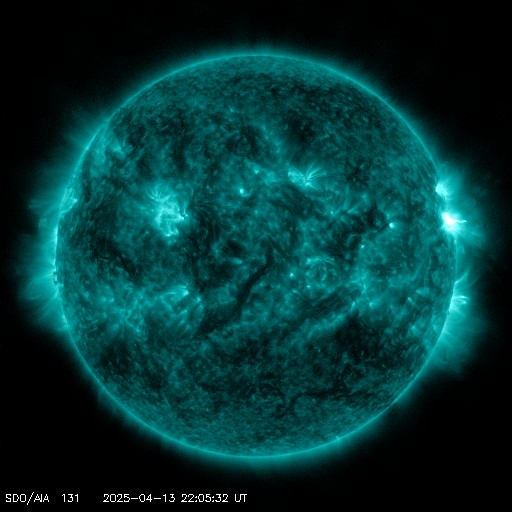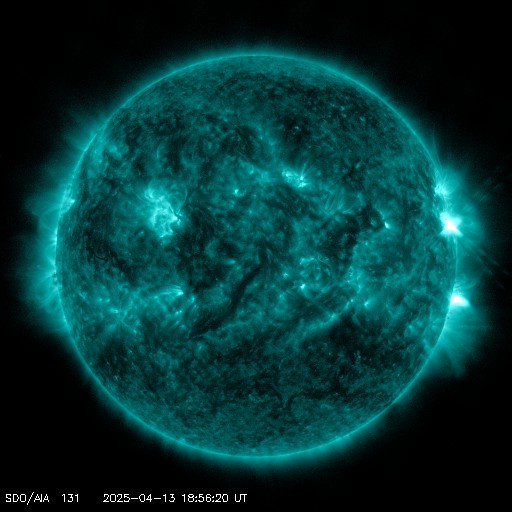Viewing archive of Friday, 6 March 2015
Daily bulletin on solar and geomagnetic activity from the SIDC
Issued: 2015 Mar 06 1223 UTC
SIDC Forecast
Solar flares
Active (M-class flares expected, probability >=50%)
Geomagnetism
Active conditions expected (A>=20 or K=4)
Solar protons
Quiet
| 10cm flux | Ap | |
|---|---|---|
| 06 Mar 2015 | 142 | 011 |
| 07 Mar 2015 | 148 | 021 |
| 08 Mar 2015 | 152 | 016 |
Bulletin
The active region that is just starting to round the southeast limb was the source of 3 M-class flares during the period. The strongest event was an M3 flare peaking at 04:57UT. It was followed by an M1.5 flare peaking at 08:15UT. A partial halo coronal mass ejection (CME) with an estimated plane-of-the-sky speed of about 600 km/s was associated to the latter event. First seen by CACTus in LASCO/C2 imagery at 07:12UT, the bulk of the CME is directed away from Earth. Based on current imagery, the CME does not seem to have an earth-directed component. NOAA 2292 produced a complex C3 flare (around 17:20UT) while rounding the southwest limb. NOAA 2293 and three other puny sunspot groups were quiet. No earth-directed CMEs were observed. Proton flux was at nominal levels. M-class flaring is expected, with a good chance on an X-class event. Quiet to unsettled geomagnetic conditions were observed, with Kp reaching active levels by the end of the period. Solar wind speed varied mostly between 400 and 500 km/s, Bz varied mostly between -7 and +8 nT. The interplanetary magnetic field was mostly directed away from the Sun. Quiet to active geomagnetic conditions are expected, with the anticipated arrival of the high speed stream from a coronal hole around 07 March.
Today's estimated international sunspot number (ISN): 022, based on 09 stations.Solar indices for 05 Mar 2015
| Wolf number Catania | /// |
| 10cm solar flux | 130 |
| AK Chambon La Forêt | 014 |
| AK Wingst | 007 |
| Estimated Ap | 007 |
| Estimated international sunspot number | 021 - Based on 20 stations |
Noticeable events summary
| Day | Begin | Max | End | Loc | Strength | OP | 10cm | Catania/NOAA | Radio burst types |
|---|---|---|---|---|---|---|---|---|---|
| 05 | 1706 | 1811 | 1826 | ---- | M1.2 | --/---- | |||
| 06 | 0414 | 0457 | 0527 | ---- | M3.0 | 120 | --/---- | III/1 | |
| 06 | 0655 | 0815 | 0828 | ---- | M1.5 | --/---- | CTM/1 |
Provided by the Solar Influences Data analysis Center© - SIDC - Processed by SpaceWeatherLive
All times in UTC
Current data suggests there is a slight possibility for aurora to appear at the following high latitude regions in the near future
Iqaluit, NUNuuk
Reykjavik
Latest news
Latest forum messages
Support SpaceWeatherLive.com!
A lot of people come to SpaceWeatherLive to follow the Sun's activity or if there is aurora to be seen, but with more traffic comes higher server costs. Consider a donation if you enjoy SpaceWeatherLive so we can keep the website online!

Latest alerts
Sunday, 13 April 2025
22:21 UTC - Solar flare
Moderate M1.66 flare from sunspot region 4055
22:03 UTC - Radio Blackout
Minor R1 radio blackout in progress (≥M1 - current: M1.01)
20:48 UTC - Hemispheric Power Index
The OVATION model predicts the Hemispheric Power Index to reach 50GW at 21:39 UTC
19:09 UTC - Solar flare
Moderate M3.24 flare from sunspot region 4055
18:51 UTC - Radio Blackout
Minor R1 radio blackout in progress (≥M1 - current: M1.07)
Space weather facts
| Last X-flare | 2025/03/28 | X1.1 |
| Last M-flare | 2025/04/13 | M1.6 |
| Last geomagnetic storm | 2025/04/06 | Kp5 (G1) |
| Spotless days | |
|---|---|
| Last spotless day | 2022/06/08 |
| Monthly mean Sunspot Number | |
|---|---|
| March 2025 | 134.2 -20.4 |
| April 2025 | 136.4 +2.2 |
| Last 30 days | 134.2 -8.9 |




